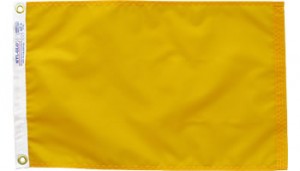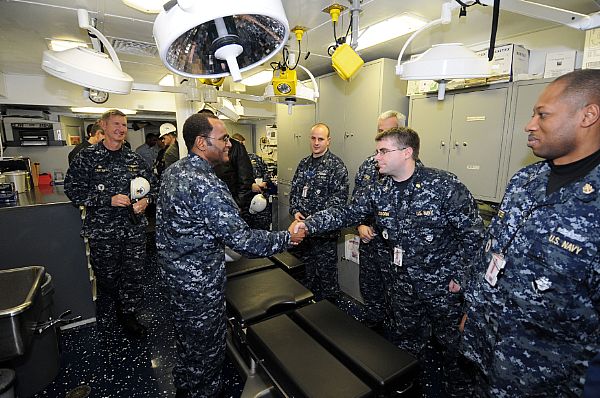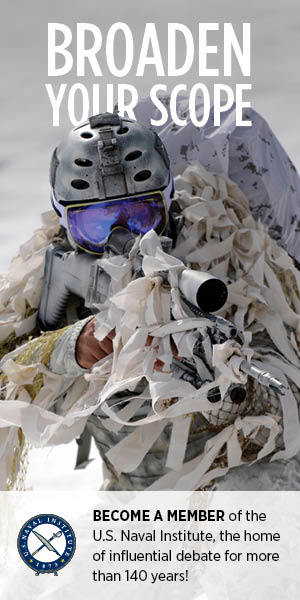 Not really. Though some 50 members of the USS Dubuque’s company are suffering flu-like symptoms (one sailor is confirmed H1N1 positive, with more test results pending), the sick are staying home, and are not aboard ship.
Not really. Though some 50 members of the USS Dubuque’s company are suffering flu-like symptoms (one sailor is confirmed H1N1 positive, with more test results pending), the sick are staying home, and are not aboard ship.
Don’t panic. Outbreaks like this are common enough, and Navy ships, in their role as, essentially, highly populated metal cans, can become superb disease incubators. So let’s not get too excited. A shipborne outbreak was due, and given that the Navy Influenza Surveillance System caught this outbreak early is reason enough to give somebody a pat on the back.
That said, the Dubuque is not going to deploy, as was planned, on June 1. The mission is forfeit. Should this outbreak scuttle the Pacific Partnership 2009? I don’t know. I hate seeing the U.S. Navy skip a visit to Kiribati, the Marshalls, Samoa, the Solomons and Tonga. They’re important islands, and we’re facing a simmering and long-term diplomatic challenge in some of them. But we’re also tied into a resource-constrained environment, and perhaps we simply don’t have the money to fund a Pacific jaunt by an older amphib. It’s a face-saving way to cut expenses. But, fate of this mission aside, if the U.S. intends to continue direct engagement with potential maritime partners, then we must be prepared to confront any and all diseases that might be shipped aboard.
Amphibs are not alone. Even our big “Blue-Water” warships are vulnerable. A disease can be tracked aboard by anybody–an ally, a detainee, a contractor, a visitor–anyone. And if a ship can’t function, or a disease compromises a mission, then that fact is good for high-level planners to know. We need to constantly re-evaluate and study the shipboard microbial environment.
If disease aboard naval vessels poses a significant threat, then we need to do a better job understanding how disease might be introduced–and, in that regard, do a better job of detecting, stopping and, ultimately, preventing virulent pathogenic stowaways. Projects like Pacific Partnership–where we engage the shore directly–can, if we have the appropriate resources available, help teach us how to manage this threat a bit better.
But the prospect for solving the underlying issue–disease getting aboard ship–is pretty slim. Shipborne disease is a ferociously difficult problem. A primary barrier is that disease aboard ship is, simply, a fact of life. All ships get sick at some point. Several pathogens are regular post-shore leave stowaways, and virtually everybody has a story to tell about a shipboard outbreak of some kind. You just grin, bear it and try not to barf on the electronics. Disease studies afloat are just not done enough.
enough.
That’s gotta change.
Two other trends are ratcheting up the potential impact of a contagious disease aboard ship. First, manning. With smaller crews, even the temporary degradation of a crew-member (or a portion of the crew) poses a still far too poorly understood risk. How well will the LCS function if, as is happening on the Dubuque, 10%-15% of the crew goes down for the count? How about the DDG-1000?
Second, given the rapidly changing pace of modern warfare, the potential tactical-level impact of disease aboard ship is too often overlooked. If an adversary needs just a few days to do something provocative, getting the local big-deck ship sick might be a pretty neat way to do it. Introduction of something like an aggressive, drug resistant strain of the bacteria that causes tuberculosis (TB) could even have a strategic impact. Drug-resistant TB infection might, over the long-term, disable a ship’s crew and vessel. (Just ask the USS Ronald Reagan how fun their TB outbreak was back in 2006.)
A flu is finished in a few days. But longer-term diseases like TB are tough to beat. Take treatment. The air surgeons may disagree, but, even if a pilot can get the clearance, it’s no fun to fly while taking a months-long course of really tough-on-the-body anti-TB antibiotics. (Anti-viral Tamiflu can be no fun, either.) In short, people are not at their best while sick (or, for that matter, while taking medication to prevent illness).
Everybody knows that putting sick crew in exacting, high-demand situations is not a recipe for battlefield dominance. But we need to do a better job of understanding how disease impacts high-end cognitive performance during–in particular–the hard-to-detect prodrome (that period where infected folks suffer non-specific symptoms at the start of their infection). We also might do well exploring diseases that have potential to target the brain or impact mental states.
But that’s all “next-war-itis.” Today, we’re facing off against Swine Flu, and for the lack of any better answers, this guidance from the Navy Surgeon General (ripped from a Navy Times article) offers some pretty robust, common-sense information:
A Navy-wide message released Friday by the Navy’s surgeon general offered ship-specific guidance to reduce the risks of disease spread. The guidance told commands to: remove every other seat in the mess decks; make sure sailors sleep with a “head-to-toe orientation” in berthing areas; reduce crowding in work areas; “maximize ventilation” aboard ship; and “consider restricting non-essential travel to areas with known outbreaks.”
Sound advice. But then again, haven’t the INSURV inspections this year hinted at a fleet-wide lack of attention to ventilation maintenance and design? I suspect so, but the details are classified and probably not getting over to the Navy’s medical folks. But, hey, that’s all fodder for another post.
PS–if you’re worried about the flu, and are looking for more information, go visit the DOD Pandemic Influenza Watchboard to learn more. Good luck and stay healthy out there!

